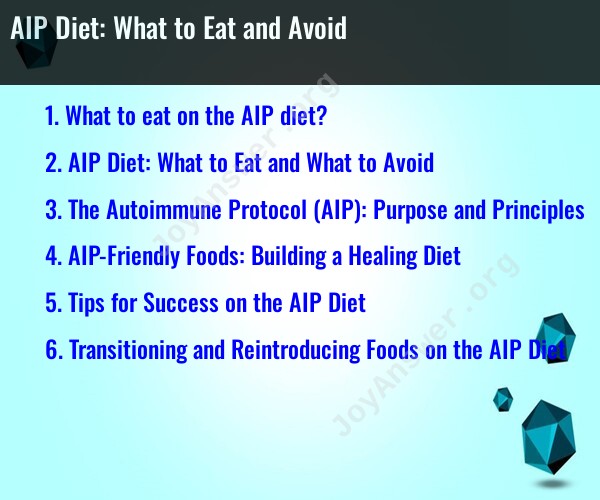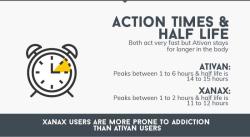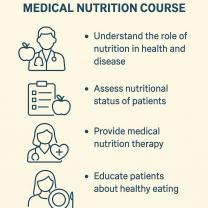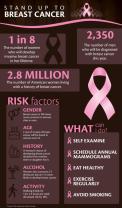What to eat on the AIP diet?
The Autoimmune Protocol (AIP) diet is a dietary approach designed to help individuals with autoimmune diseases reduce inflammation, alleviate symptoms, and identify potential trigger foods. The AIP diet involves both foods to eat and foods to avoid. Here is a general guideline on what to eat on the AIP diet:
Foods to Eat on the AIP Diet:
Vegetables:
- A wide variety of non-nightshade vegetables, including leafy greens, broccoli, cauliflower, carrots, sweet potatoes, and squash.
Fruits:
- Berries, apples, pears, and other low-sugar fruits in moderation.
Quality Proteins:
- Grass-fed and pasture-raised meats, such as beef, lamb, and poultry.
- Wild-caught fish and seafood.
Organ Meat:
- Organ meats like liver and kidney are nutrient-dense and can be beneficial.
Healthy Fats:
- Avocado, coconut products (coconut oil, coconut milk), and extra virgin olive oil.
Bone Broth:
- Homemade bone broth can be soothing and nutrient-rich.
Herbs and Spices:
- Most herbs and spices, except for nightshades and seeds.
Coconut Products:
- Coconut milk, coconut oil, and coconut aminos.
Non-Dairy Fermented Foods:
- Sauerkraut, kimchi, and coconut yogurt made without additives.
Herbal Tea:
- Herbal teas without caffeine or added ingredients.
Foods to Avoid on the AIP Diet:
The AIP diet is highly restrictive, and many foods are eliminated to reduce potential triggers for autoimmune reactions. Foods to avoid include:
Grains:
- Wheat, barley, oats, and other gluten-containing grains.
- All other grains, including rice, corn, and quinoa.
Legumes:
- All types of beans, lentils, and peanuts.
Nightshades:
- Tomatoes, potatoes, peppers, eggplants, and spices like paprika and chili peppers.
Dairy Products:
- All dairy, including milk, cheese, and yogurt.
Processed Foods:
- Processed and packaged foods that may contain additives, preservatives, and artificial ingredients.
Refined Sugars:
- Refined sugars, artificial sweeteners, and sugary treats.
Seed-Based Spices:
- Spices derived from seeds, such as cumin, coriander, and fennel.
Eggs:
- Eggs can be a common allergen and are often eliminated during the elimination phase.
Nuts and Seeds:
- All nuts and seeds, including their oils.
Alternative Flours:
- Almond flour, coconut flour, and other grain-free flours.
It's important to note that the AIP diet is typically followed in two phases: an elimination phase and a reintroduction phase. During the elimination phase, you avoid all the foods listed above. In the reintroduction phase, you gradually reintroduce certain foods to identify which ones may be triggers for your autoimmune symptoms.
Before starting the AIP diet or making significant dietary changes, it's advisable to consult with a healthcare professional or a registered dietitian, as the diet can be challenging and requires careful planning to ensure adequate nutrition. Additionally, it's essential to monitor your health and symptoms while on the AIP diet to assess its impact on your autoimmune condition.
AIP Diet: What to Eat and What to Avoid
What to Eat:
- Meat: Grass-fed beef, lamb, pork, poultry, and game meats
- Fish and seafood: Wild-caught fish and shellfish
- Vegetables: Non-starchy vegetables, such as leafy greens, cruciferous vegetables, root vegetables, and summer squashes
- Fruits: Berries, avocados, and lemons
- Oils: Olive oil, avocado oil, and coconut oil
- Herbs and spices: Most herbs and spices are allowed, except for nightshade spices, such as paprika, cayenne pepper, and chili powder
What to Avoid:
- Grains: All grains, including wheat, rice, oats, and corn
- Legumes: All legumes, including beans, peanuts, and lentils
- Nuts and seeds: All nuts and seeds, except for macadamia nuts and Brazil nuts
- Dairy products: All dairy products, including milk, cheese, and yogurt
- Nightshade vegetables: Tomatoes, potatoes, peppers, and eggplants
- Eggs: Eggs are controversial on the AIP diet, and some people may need to avoid them.
- Coffee and alcohol: Coffee and alcohol are not allowed on the AIP diet.
The Autoimmune Protocol (AIP): Purpose and Principles
The AIP diet is an elimination diet that aims to reduce inflammation and promote healing in people with autoimmune diseases. Autoimmune diseases are conditions in which the body's immune system mistakenly attacks its own tissues and organs.
The AIP diet is based on the principle that certain foods can trigger inflammation and worsen autoimmune symptoms. By eliminating these foods from the diet, people with autoimmune diseases may be able to reduce their symptoms and improve their overall health.
AIP-Friendly Foods: Building a Healing Diet
There are many delicious and nutritious foods that are allowed on the AIP diet. Here are some ideas for building a healing diet:
- Breakfast: Omelet with vegetables, berries, and nuts; smoothie made with AIP-friendly ingredients; avocado toast with hard-boiled eggs
- Lunch: Salad with grilled chicken or fish; soup with bone broth and vegetables; sandwich on AIP-friendly bread with lean protein and vegetables
- Dinner: Salmon with roasted vegetables; chicken stir-fry with brown rice noodles; beef stew with sweet potatoes and carrots
Tips for Success on the AIP Diet
Here are a few tips for success on the AIP diet:
- Plan your meals ahead of time. This will help you to avoid making unhealthy choices when you are hungry.
- Cook at home whenever possible. This will give you control over the ingredients in your food.
- Find a supportive community. There are many online and in-person communities for people on the AIP diet. Connecting with others who are following the diet can help you to stay motivated and on track.
Transitioning and Reintroducing Foods on the AIP Diet
Once you have been on the AIP diet for a period of time, you may want to start reintroducing foods that you have eliminated. This should be done slowly and carefully, one food at a time.
To reintroduce a food, start by eating a small amount. Wait a few days to see if you experience any reactions. If you do not experience any reactions, you can gradually increase the amount of food that you eat.
If you do experience a reaction to a food, stop eating it and wait a few weeks before trying it again. It is important to be patient and to listen to your body during the reintroduction process.
Conclusion
The AIP diet is a challenging but rewarding diet for people with autoimmune diseases. By following the AIP diet, people with autoimmune diseases may be able to reduce their symptoms, improve their overall health, and live a better quality of life.












